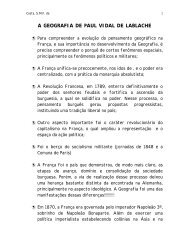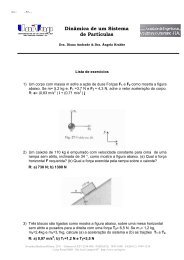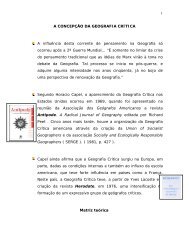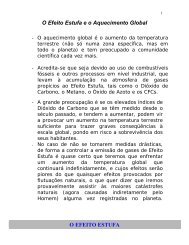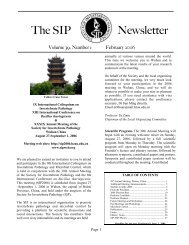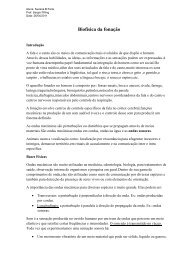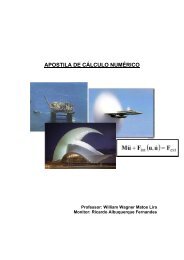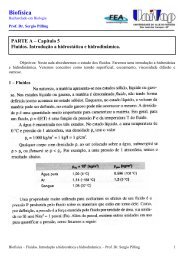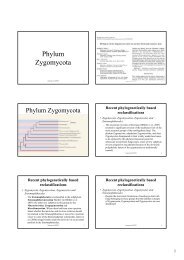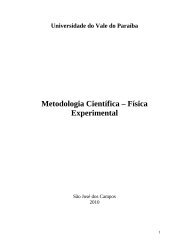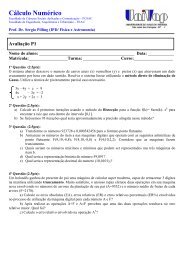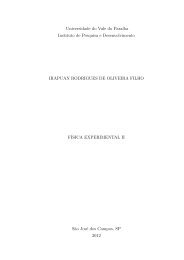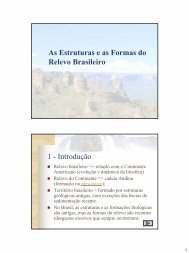Effects of Er:YAG laser irradiation and manipulation ... - Univap
Effects of Er:YAG laser irradiation and manipulation ... - Univap
Effects of Er:YAG laser irradiation and manipulation ... - Univap
You also want an ePaper? Increase the reach of your titles
YUMPU automatically turns print PDFs into web optimized ePapers that Google loves.
Silva Soares et al.: <strong>Effects</strong> <strong>of</strong> <strong>Er</strong>:<strong>YAG</strong> <strong>laser</strong> <strong>irradiation</strong> <strong>and</strong> <strong>manipulation</strong> treatment on dentin components, part 2…<br />
Table 1 Description <strong>of</strong> group treatments.<br />
Groups<br />
Group A<br />
Group B<br />
Subgroups<br />
Control group CG<br />
tube <strong>and</strong> a SiLi detector cooled by liquid nitrogen N 2 . The<br />
spectrometer was coupled to a computer system for data acquisition<br />
<strong>and</strong> processing. The voltage in the tube was set at<br />
50 kV, with automatic adjustment <strong>of</strong> the current <strong>and</strong> incident<br />
beam diameter <strong>of</strong> 50 m.<br />
Three spectra from each area subgroup were collected before<br />
<strong>and</strong> after the treatments. Three points within the same<br />
line were selected so that the first point was located in the<br />
center <strong>of</strong> the irradiated area <strong>and</strong> two other points were selected<br />
1mm from the center. The measurements were performed<br />
with a count rate <strong>of</strong> 100 s per point live time <strong>and</strong> a<br />
dead time <strong>of</strong> 25%. The energy range <strong>of</strong> scans was<br />
0.0–40.0 eV. The equipment was calibrated <strong>and</strong> adjusted using<br />
certified commercial stoichiometric hydroxyapatite Aldrich,<br />
synthetic Ca 10 PO 4 6 OH 2 , grade 99.999%, lot<br />
10818HA as a reference. The measurements were collected<br />
using classic parameters for Ca <strong>and</strong> P X-ray emission. The<br />
elements oxygen O <strong>and</strong> hydrogen H were used as a chemical<br />
balance. Energy calibration was performed using<br />
equipment-specific internal st<strong>and</strong>ards.<br />
2.3.1 EDXRF mapping<br />
Elemental distribution maps were performed for one specimen<br />
from each group A <strong>and</strong> B in order to determine the<br />
surface distribution <strong>of</strong> the elements Ca <strong>and</strong> P after treatment.<br />
For each subgroup, the maps were scanned using 50 kV in<br />
real-time scanning acquisition 1 s per point, covering an<br />
area <strong>of</strong> 8060 points with steps <strong>of</strong> 20 m <strong>and</strong> scan time <strong>of</strong><br />
320 min per area per group. The elemental mapping parameters<br />
were set similarly to those used for scanning measurements<br />
by points.<br />
2.4 Statistical Analysis<br />
Manipulation process<br />
Autoclaving 121 °C 15 min, with<br />
pressure <strong>of</strong> 1.1 kgf/cm 2 <br />
0.1% aqueous thymol solution one<br />
week<br />
Surface treatments<br />
37% phosphoric acid 15 s<br />
Group I GI <strong>Er</strong>:<strong>YAG</strong> <strong>laser</strong> 80 mJ, 3 Hz, 12 J,<br />
153 pulses<br />
Group II GII <strong>Er</strong>:<strong>YAG</strong> <strong>laser</strong> 120 mJ, 3 Hz, 12 J,<br />
103 pulses<br />
Group III GIII <strong>Er</strong>:<strong>YAG</strong> <strong>laser</strong> 180 mJ, 3 Hz, 12 J,<br />
70 pulses<br />
The measurements <strong>of</strong> Ca, P, <strong>and</strong> the Ca/P ratio obtained by<br />
X-ray fluorescence were analyzed using Instat s<strong>of</strong>tware<br />
GraphPad S<strong>of</strong>tware, Inc., San Diego, CA, USA. Statistical<br />
analyses were performed using the difference between normal<br />
<strong>and</strong> treated values yielded by the X-ray fluorescence results.<br />
Comparisons between decontamination <strong>and</strong> storage treatment<br />
groups subjected to the same type <strong>of</strong> surface etching were also<br />
performed. Those comparisons were performed using the<br />
Mann–Whitney U test. Comparisons among surface treatments<br />
in the same decontamination/storage treatment groups<br />
were performed using the one-way ANOVA test at a 95%<br />
confidence level <strong>and</strong> the Tukey–Kramer multiple comparisons<br />
test.<br />
3 Results <strong>and</strong> Discussion<br />
All experimental samples showed lower Ca/P weight ratios<br />
than those <strong>of</strong> stoichiometric hydroxyapatite, which is calculated<br />
as 2.15. This observation indicates that the dental hydroxyapatite<br />
as biological hard tissue is nonstoichiometric,<br />
as reported in the literature. 23 Statistical comparisons <strong>of</strong> Ca<br />
<strong>and</strong> P content as well as Ca/P weight ratio were performed<br />
for normal <strong>and</strong> treated specimens in all experimental groups<br />
Table 2, horizontal comparisons. Statistical analysis showed<br />
that the amounts <strong>of</strong> Ca Ca weight % <strong>and</strong> P P weight %<br />
decreased significantly in the autoclaved specimens <strong>and</strong> in<br />
those treated with phosphoric acid ACG, as compared with<br />
the autoclaved untreated specimens Table 3, rows 1 <strong>and</strong> 2.<br />
Therefore, for this group the weight ratio Ca/P increased<br />
significantly Table 3, row 4. However, no significant differences<br />
were found between the quantities <strong>of</strong> Ca <strong>and</strong> P, in gram<br />
atom percentage, before <strong>and</strong> after treatments in the specimens<br />
stored in thymol <strong>and</strong> treated with phosphoric acid BCG<br />
P0.05.<br />
Lower quantities <strong>of</strong> phosphorus were found in the acidetched<br />
specimens that had been autoclaved than in those<br />
treated with thymol Table 3, row 3. The Ca/P weight ratio<br />
increased significantly for the acid-etched specimens that had<br />
previously been autoclaved as compared to those treated with<br />
thymol Table 3, row 5.<br />
Differences among etching treatments were found only in<br />
the autoclaved specimens, as shown by the Tukey–Kramer<br />
test. Calcium levels were lower in the acid-etched specimens<br />
than in those subjected to <strong>laser</strong> <strong>irradiation</strong> <strong>of</strong> 120 mJ P<br />
0.01 Table 2, column 3. Phosphorus levels were lower in<br />
the acid-etched specimens than in those subjected to <strong>laser</strong><br />
<strong>irradiation</strong> <strong>of</strong> 80 mJ P0.05, 120 mJ P0.001, <strong>and</strong><br />
180 mJ P0.01 Table 2, column 5. The Ca/P weight<br />
ratio was higher in the acid-etched specimens than in those<br />
that were <strong>laser</strong>-irradiated P0.01 Table 2, column 7.<br />
The results <strong>of</strong> the elemental analysis in the present study<br />
showed that the amounts <strong>of</strong> calcium Ca weight % <strong>and</strong> phosphorus<br />
P weight % were reduced in the autoclaved specimens<br />
treated with 37% phosphoric acid 15 s. The calciumto-phosphorus<br />
weight ratio also increased significantly. Acid<br />
etching dissolved peritubular <strong>and</strong> intertubular dentin, significantly<br />
removing chemical compounds containing Ca <strong>and</strong> P.<br />
Heat <strong>and</strong> pressure effects 121 °C <strong>and</strong> pressure <strong>of</strong><br />
1.1 kgf/cm 2 likely explain the intense effect observed in autoclaved<br />
specimens as opposed to those treated with thymol.<br />
For this group ACG, the results are in agreement with previous<br />
studies obtained by dispersive Raman spectroscopy. 14<br />
White et al. 17 used FTIR spectroscopy to investigate the sterilization<br />
effects <strong>of</strong> steam autoclaving on whole tooth roots.<br />
They found that this treatment induced a loss <strong>of</strong> mineral <strong>and</strong><br />
collagen components as shown by reduction in amine <strong>and</strong><br />
Journal <strong>of</strong> Biomedical Optics 024002-3<br />
March/April 2009 Vol. 142



